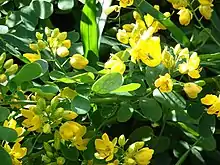Senna pendula
Senna pendula, also known as Easter cassia, climbing cassia, winter senna and valamuerto,[1] is a plant of the Fabaceae family with a shrub habit that is native to South America. It used in various parts of the world as an ornamental plant and is an environmental weed in Australia. The flowers of this plant are yellow or greenish yellow and the name pendula means 'pendulous' or 'drooping'.[2]
| Senna pendula | |
|---|---|
 | |
| Scientific classification | |
| Kingdom: | Plantae |
| Clade: | Tracheophytes |
| Clade: | Angiosperms |
| Clade: | Eudicots |
| Clade: | Rosids |
| Order: | Fabales |
| Family: | Fabaceae |
| Genus: | Senna |
| Species: | S. pendula |
| Binomial name | |
| Senna pendula | |
Description
_flowers_(28914825366).jpg.webp)
It is a spreading, scrambling or erect shrub that reaches 2-4 metres in height with multi-branched and arching stems and branches. Its single-compound, hairless leaves feature three to six duos of wide leaflets that are 1-5 cm long and 5-20 mm wide with rounded tips and salient yellowish margins.[3]
Its bright yellow flowers, which are about 3 cm across, have five large petals and are foaled in leafy clumps at the tips of the branches. The fruit is in a cylindrical pod (10-20 cm long and 6-12 mm wide) that hangs down. It flowers year round, but more prominently in Easter, hence its common name.[4]
Senna pendula is distinguished from Senna bicapsularis which has 3 pairs of leaflets on each leaf, while this one has 4-7 pairs of leaflets on each leaf and a gland between each pair of leaflets.
Invasive species
The S. p. glabrata variety has become naturalised, and is also an environmental weed, in eastern Australia in the coastal and sub-coastal regions of south-eastern Queensland and New South Wales, where it is found in watercourses, gardens, disturbed sites, wastelands, roadsides, closed forests, forest margins and urban bushland.[5]
Subspecies
The plant features the following subspecies:[6]
- S. p. advena
- S. p. ambigua
- S. p. dolichandra
- S. p. eriocarpa
- S. p. glabrata
- S. p. hemirostrata
- S. p. indistincta
- S. p. meticola
- S. p. mission
- S. p. ovalifolia
- S. p. paludicola
- S. p. pendula
- S. p. praeandina
- S. p. recondita
- S. p. scandens
- S. p. stahlii
- S. p. tenuifolia
Gallery
 Budding flowers
Budding flowers Growing at a farmland
Growing at a farmland
 Seed pods
Seed pods Scrambling on a fence
Scrambling on a fence_H.S.Irwin_%5E_Barneby_-_Flickr_-_Alex_Popovkin%252C_Bahia%252C_Brazil_(3).jpg.webp) Leaves closeup
Leaves closeup_H.S.Irwin_%5E_Barneby_-_Flickr_-_Alex_Popovkin%252C_Bahia%252C_Brazil_(6).jpg.webp) Flower closeup
Flower closeup Leaves and flowers
Leaves and flowers
References
| Wikispecies has information related to Senna pendula. |
| Wikimedia Commons has media related to Senna pendula. |
- Senna pendula var. Glabrata by Weeds of Australia (biosecurity Queensland edition), Queensland Government. Retrieved 13 April 2020
- Irwin, HS & Barneby, RC, 1982 Mem.New York Bot.Gard.35: 1-918 [in 2 parts] American Cassiinae
- Senna pendula var. Glabrata by Australian Tropical Rainforest Plants. Retrieved 13 April 2020
- Irwin.H.S.& Barneby,R.C., 1982 Mem.N.Y.Bot.Gard.35(1 & 2):1-918 The American Cassiinae
- Easter cassia Senna pendula var. Glabrata by the Brisbane City Council Weed Identification Tool. Retrieved 13 April 2020
- Hyde, M.A., Wursten, B.T. & Ballings, P. (2013). Flora of Zimbabwe: Species information: Senna pendula var. glabrata.